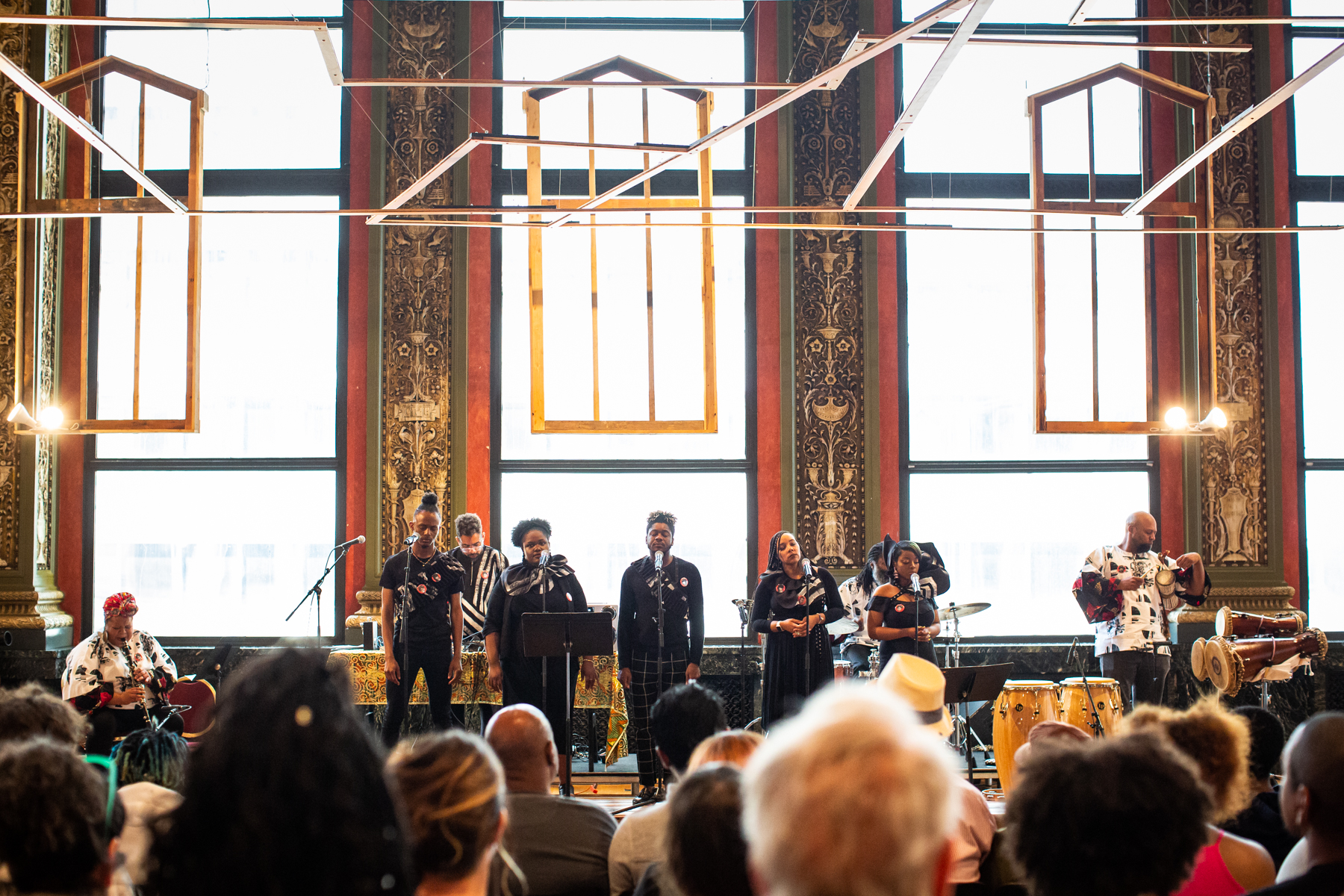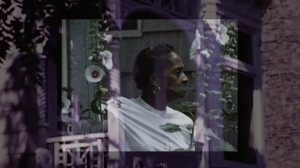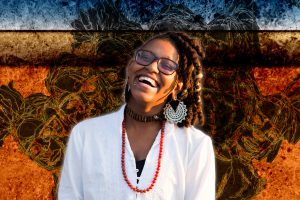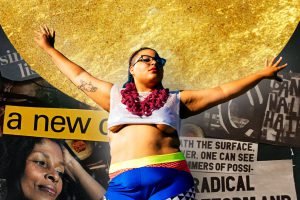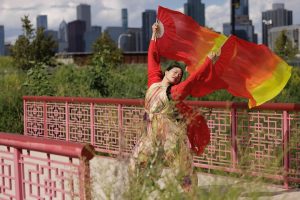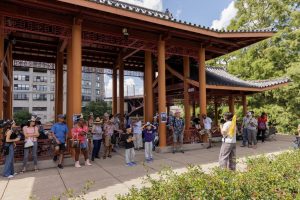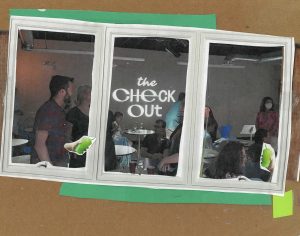“Please join me in welcoming the Black Monument Ensemble.” The crowd roars with claps, whistles, loud whoops, and yelps. Applause melts behind wind chimes and bells as the band, singers, and dancers make their way to the stage. The audience quiets in anticipation. The voice of Damon Locks resounds in the room before his body appears.
“Knowing what we know now, the mind searches for reconciliation…”
Stationed behind the singers, dancers, and drummers, he stands near his keyboard speaking into a telephone receiver attached to a soundboard. His voice reverberates throughout the space, bouncing against the drum sounds and vibrations as he recites his “Statement of Intent.” The drum intensifies and reaches a crescendo. “Some things never change–Black monuments!”, Locks yells. Angel Bat Dawid begins playing her clarinet. The choir begins.
I become transfixed by the electric synergy that emits from the band to the dancers, from the dancers to the singers, from the collective to the audience. The voices of Ruby Dee, Angela Davis, and Lena Horne coil around and reverberate within our ears. Suddenly we’re no longer at the Chicago Cultural Center. We’re hovering within liminal space, not knowing where our present ends and the future unfolds.
Black Monument Ensemble began as an emotional conduit for Locks to process heavy emotions incited by the racial and political oppressions faced by Black and Brown folks–the catalyst being the murder of Mike Brown. What started as a simple setup of a mic, sampler and drum machine grew into a 15-piece performance collective, including clarinetist Angel Bat Dawid, drummer Dana Hall, percussionist Arif Smith, dancers such as Keisha Jane and a group from Move Me Soul (Bryonna Young, Tiarra Young, Cheyenne Spencer, and Raven Lewis), and singers (Phillip Armstrong, Monique Golding, Rayna Golding, Tramaine Parker, Eric Tre’von, Erica Nwachukwu, some formerly from the Chicago Children’s Choir). BME’s ode to likes of the Artistic Heritage Ensemble, Sun Ra Arkestra, and The Association for the Advancement of Creative Musicians (AACM) is undeniable.
This interview was edited for clarity and length.
Ireashia Bennett: Can you tell me what made you decide to become a visual sound artist and what has your career path been like?
Damon Locks: Well, I don’t think I decided to be both of those things. Those are just things that I’ve been doing, you know? I’ve been a visual artist since I was a child, and I started being in bands when I was 14. It wasn’t until I quit my job at the end of 2007 that I was like, “Well, okay, what is it going to look like to be a visual artist and a musician?” So, I’ve always been in bands and, most recently, in the last four years, I decided to step out and do something kind of inspired by my own thoughts, as opposed to the collective musician band thing. I started doing solo electronic— drum machines, samplers—pieces, and those were normally kind of civically-engaged pieces. Because I started doing this around the death of Mike Brown and where people were getting murdered like every day. Every week, there was a new person. And I was like, “I’ve gotta process this somehow.” I wanted to process it through sound. And it was that kind of exploration that kind of unfolded into the Black Monument Ensemble.
IB: Nice. What do you find most challenging about working as an artist?
DL: Hmm. What’s the most challenging? [pause] I think, often times, it’s figuring out ways to support your art practice—it’s challenging—and then it’s also how do you support the growth of projects. Most of the time, the ideas are there, it’s just how do you make them happen. I think that’s about the biggest challenge.
IB: Yeah. I definitely feel you on not just funding but also making sure that this idea is fully fleshed out and not surface-level. I think the most rewarding part of being an artist is to see a project or an entity through. And to see how other people—like people you bring into the project and collaborate—how they add to the project too. I see that collaboration in the Black Monument Ensemble. It feels central to the piece, to the project. Do you think that’s a correct assumption?
DL: That collaboration is central to the project? [Ireashia affirms] Yeah, I think very much so. I think this project was birthed from the—conceptually, and lyrically, and what the piece is about—all the collaborators bring amazing, wonderful things to the table, and most of them are things that I probably wouldn’t have conceived of. [laughs] It’s a really humbling experience to have such talented people bring their energies to the project, and help it become something bigger than I expected, or greater.
IB: Yeah. I love how your work, especially with Where Future Unfolds, it kind of speaks to the history of community activism in Chicago. Can you share how that backdrop and that history kind of inspired and also influenced Where Future Unfolds?
DL: Growing up, I was really inspired by music that had [an] impact on the world— or the place that we live, not just impact on the music world. For example, I remember when Public Enemy put out “By the Time I Get to Arizona,” the video where he was blowing up the mayor’s office or something like that. And it was because they were not acknowledging Martin Luther King Day, right? After the record came out, they were on the news. And so it was like Sister Souljah and Chuck D on the news discussing their work. And I was like, “This is amazing.” And it wasn’t just them. Tons of people—and a lot of it was hip-hop—were in the news talking about their work, and it was impacting people on a day-to-day basis. I was really fascinated by that. There’s plenty of examples of that. Like as a kid I grew up listening to disco and soul music and stuff, because I’m pretty old, and then when I got into junior high school, I started listening to punk music and found out that, like, the Sex Pistols were on TV and they caused a national disturbance and the whole country was mad at them. And I was like, “How do you make a band that people are affected by?” And, as I got older, I started to look at— when my palette expanded—I started to look at musical collectives that were often Black jazz groups of the ‘60s. And I found what they were doing to be very interesting. And groups like Phil Cohran—who’s from here; Artistic Heritage Ensemble. He was involved with the Sun Ra Arkestra and then created his own group here and other groups that were part of the AACM, which is a Chicago-based music collective of sorts. And I started to look at how they would operate, and how they would be connected to community, and make work in these kinds of large groups with civically engaged themes. And that seems like a really good model and something that could be useful today.
IB: Mmm hmm. I was at your performance at the Garfield Park Conservatory last November–
DL: Oh, great.
IB: –and it was my first time witnessing your work. I didn’t really know what to expect. But I was like, “Okay, Black Monument–“ It just sounded really cool.
DL: Why did you go?
IB: I went because, well, the art was really amazing. [laughs] And I was like, “This has to sound cool. It has to be cool.” Because, one, the album art or I guess the promo art on the Red Bull [promo flyer]– It just seemed really different. And I went and I was completely blown away. I didn’t even feel like I was in Chicago anymore. Like, from the vocals to the instrumentation to the dancers and the costumes—everything just flowed together as one. Everything just felt like, it just added upon added to the music, and just the experience. And I just really enjoyed how that was curated, and it felt really thoughtful. Can you expand on how each element to your performances enhance, I guess, the message and the experiences of your music?
DL: [It] goes back to the artistic excellence of the collaborators. Like, each person brings an intention—an in-tention, at-tention, and just a mastery of what they can do—to the table. If you have 16 elements, and each element is bringing at 100%, it’s going to be super deep. I can’t stress that enough. It is still also working with intention on all of the aspects of the performance. Production mode—Jamie Hayes, who made the costumes—we talked about design ideas, she came up with the designs, and I painted some of the fabric and designed elements for the screen-printed fabric. I made buttons for it that everyone wore, these red buttons with different Black artists on them. And I think it’s just an experiment in working with intention. Because each of the artists work with intention, and if you pay attention to all of the elements down the line, you see what happens is that people have different ways of accessing and connecting to the work, whether it’s through the dancers or through the visuals or through the percussion, through the vocals. Because any of those elements could stand alone, as far as I’m concerned. Does that answer the question?
IB: Absolutely, yeah. I really appreciate that about what I saw at the Garfield Park Conservatory. Throughout the performance, you weave these samples, these words [and] phrases, with your digital sounds and live instruments. It sounds like both a call and response and also a continuation of thought between the past and the present. Can you speak more about your experiences just picking these sounds out? And what inspired you to use archival sounds in that way?
DL: Well, archival sounds were the impetus for the work, originally. I was trying to figure out a way of kind of artistically navigating these tense and racist and misogynistic and homophobic and transphobic times that we live in. And just trying to figure out how to navigate it. I was looking back at the Civil Rights Era for inspiration and listening to recordings. I was doing my very first performance in a space called Art In These Times, and the show was a survey of racist postcards. And, it was filled with images—stereotypical, derogatory images of Black people. The argument was that as soon as the U.S. Mail became a thing, people started sending these images around the whole country, and disseminating these stereotypes that we still see today. You saw those stereotypes around eating watermelon and things like that. I saw that show and I’d been trying to process the world, and I thought, “What if I do a show in here, in this space, as a piece of programming?” And I asked the curators, and they said yes. So, I had to figure out what I was going to do. And I was just like, trying to figure out what it was going to look like because I had never performed solo before on my own. I was in the car with my friend Jamie, who would later design the costumes, and this Pointer Sisters song came on, “Yes We Can Can,” which was written by Allen Toussaint, from Louisiana. And I was like, “Oh, ‘Sounds Like Now.’ That’s what I’m going to call this piece. And I’m going to go back and pull out my records and listen to all the recordings I have of people from the Civil Rights Era talking about the same stuff that we’re dealing with right now.”
I created a sound piece that was—I created sound beds—that then you could listen to these voices, whether it was Ruby Dee or Angela Davis or Ossie Davis or Fred Hampton or whomever, and you could hear them in a contemporary setting and really listen. I sang a song at the end that was “Sounds Like Now.” I started to think about these voices and where I hear these voices the same way I think about visuals for collage. I’m able to recognize something that would be nice to juxtapose with something else. Also, I’ve gotten better at being able to […] find ways of connecting to the rhythmic aspects of a voice, and connect it to music. So that when you hear someone, like Lena Horne, speaking, it sounds like it was made for the music that’s behind it. I feel like those voices were put on record, or put on recordings, in order for people to hear them, and if I can keep putting those voices forward, it’s actually a really great thing. It helped me feel connected to a lineage of artists and creators and other things that have been dealing with issues.
IB: Yeah. You bring up a really great point, about just remembering, but also just bridging that gap, and making sure that these voices aren’t forgotten. When I was in the audience, I remember feeling like all these waves of emotions that were kind of conflicting. Where were you emotionally, and how much of your feelings and your thoughts were put into this work?
DL: That’s something I had to think about a lot in terms of the content. Like I think you were talking about the experience of the content, and how there’s a lot of things happening there. And I had to think about, what is the result? What do I want out of the music and the experience? And how do you make work about these issues without just dwelling in them? And it’s kind of a fine balance, and something I stay conscious of. Because there are things that are really complex and difficult and sometimes they just have to be complex and difficult. One of the things I think I’m very excited about with Black Monument is that it might be talking about some difficult issues, but, at the same time, it’s like a group full of people turning it into something really lovely. Like they’re actively doing, making beautiful things. And I think that’s a juxtaposition that works in its favor.
IB: Yeah, it always is. [laughs] Unfortunately. And I guess fortunately. When you think about Chicago’s Black artist scene right now, what are you most excited about?
DL: Well, I think that a lot of people have been working for a long time, and I feel like we’re in a– We all know that there’s a politically terrible moment that we’re in, and I can only hope that that’s a moment. I mean, this moment’s been going on for a long time, it just takes different shapes, and this shape is really terrible. But I feel like there’s a lot of people that have been doing a lot of great work, and I feel like the larger community—I’d say the larger arts community—the larger community realizes that they need the artists. A lot of great people that have been working really hard for a long time are being utilized. People are realizing that this stuff is useful and helpful. It’s really nice to see that people’s hard work is being appreciated and also, I think, everything’s work is– I mean, people’s work is being utilized. It should be active, it should be something people are engaged with. I’m really happy to see that people are engaging with artists’ work.
IB: Absolutely. What is the future of the Black Monument Ensemble? What’s y’all’s summer, fall, winter looking like? [laughs] And beyond.
DL: I think that one of the things that’s really important, as the opportunities grow for Black Monument, is I want to make sure that the things that we [are] involved in can be really generative. And I want them to be generative for the people performing in the group as well as the people that are seeing the performance. I’m very interested in making a positive experience that has a special feeling. I’m less interested in just having a concert. It’s going to take some extra work and some extra concentration to figure out what to say “yes” to and what to say “no” to. But it’s a challenge that I’m excited by. I was very happy that I’ve been connected to some very wonderful organizations that have helped grow this. The Hyde Park Art Center was a place that I had a residency at and which was when I put together the vocal group. We had rehearsals at the Hyde Park Art Center and our first performance was like, we just opened the doors to my studio and we did a concert! I enjoy these spaces that provide art to people. It was a dream of mine to go to the Garfield Park Conservatory where we can actually literally breathe different air because it’s affected by the plants, but then also take the record release and put it in a community space. All of these experiences have helped me shape what Black Monument could be, and trying to feed through Black Monument so that the joy, the sadness, the confusion, or the frustration that is in the art gets to people. That it can reach people, and feel positive.
IB: Yeah. I love that you are—I don’t know—maintaining openness and a groundedness in community and making sure that, wherever you are, it’s accessible, and nothing is behind closed doors or within ivory towers or whatever, and I really appreciate that. [laughs]
DL: Thank you. I mean, I think– Yeah. It seems to make sense. There was a collective in Chicago in the ‘60s, AfriCOBRA. And AfriCOBRA—Barbara Jones-Hogu—would oversee these screenprints that they would make and they would sell them for like $10! Because they thought that people should have art in their houses! You know, own art. And I thought, “That’s brilliant! That’s great!” You don’t have to sell it for the most amount of money, just figure out ways to get it to people. I feel like there’s the old punk rocker in me that looks at this kind of post-apocalyptic world that we’re living in. [laughs] In my mind, we’ve been apocalyptic for a long time and now we’re post-apocalyptic. And in a post-apocalypse, we gotta help each other out. I don’t think that we should be looking to these larger structures to support us. We have to support each other. If you want to make some stuff, make it so people can see it, or they can have it, or they can look at it, hear it.
Featured Image: The Sydney Yates Gallery at the Chicago Cultural Center was the backdrop for the Black Monument Ensemble performance, with its large windows, ornate architecture, and suspended wooden frames. Photo by Kristie Kahns
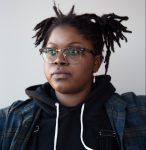
Ireashia Bennett is a Chicago-based writer, photographer, and filmmaker originally from Suitland, MD. Their work can be viewed at www.ireashiamonet.com.
